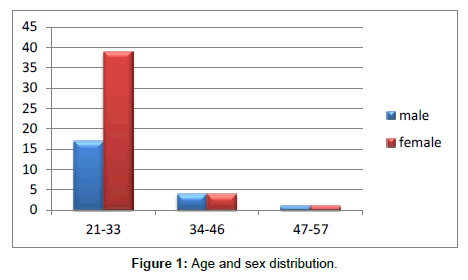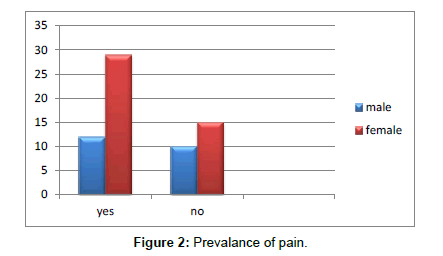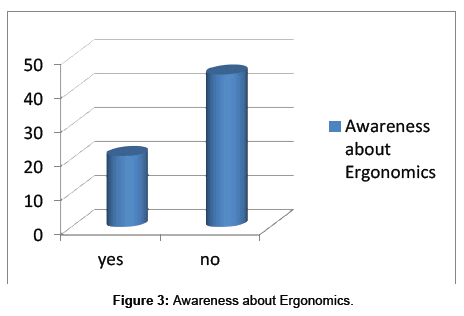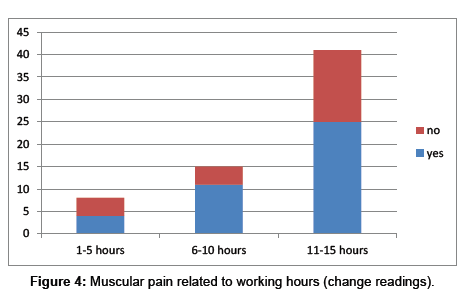Research Article Open Access
Assessment of Ergonomic Decencies; at Work Dentists
Shahbaz Ahmed1, Naseer Ahmed2 and Saba Faruqui3*
1Department of operatives, Ishrat Ul Ebad Khan Institute of Oral Health Sciences, Pakistan
2Department of Prosthodontics, Altamash Institute of Dental Medicine, Pakistan
3Altamash Institute of Dental Medicine, Pakistan
- *Corresponding Author:
- Dr. Saba Faruqui
BDS, Altamash Institute of Dental Medicine
House no 100, Phase 6, Street 1, khy-e-muhafiz.dha.karachi
Karachi, Pakistan
Tel: 0321-2356593
E-mail: Sabafaruqui23@gmail.com
Received Date: April 04, 2016; Accepted Date: May 07, 2016; Published Date: May 14, 2016
Citation: Ahmed S, Ahmed N, Faruqui S (2016) Assessment of Ergonomic Decencies; at Work Dentists. J Interdiscipl Med Dent Sci 4:196. doi: 10.4172/2376-032X.1000196 J Interdiscipl
Copyright: © 2016 Ahmed S, et al. This is an open-access article distributed under the terms of the Creative Commons Attribution License, which permits unrestricted use, distribution, and reproduction in any medium, provided the original author and source are credited.
Visit for more related articles at JBR Journal of Interdisciplinary Medicine and Dental Science
Abstract
Background: To evaluate work place efficiency and prevalence of musculoskeletal problems in practicing local dentists.
Materials and methods: This multicenter cross sectional study was conducted in duration of one year, a total of 66 dentists, who met the inclusion and exclusion criteria participated in this study. The Data collection was obtained by means of a structured questionnaire to evaluate ergonomics. The variables evaluated were: presence of pain, affected zones, gender, small breaks between work.
Results: After statistical analysis it was state that higher numbers of practicing dentists were suffering from musculoskeletal problems of some kind.
Conclusion: It is important to increase the awareness regarding the term ergonomics so dentists can be release from doing work in an awkward posture and can provide high quality service without threatening their professional careers.
Keywords
Ergonomics; Musculoskeletal disorders; Muscular pain
Introduction
In recent times ergonomics has become a popular term. The term has been used with most professions but increasingly in the dental profession [1]. It is a Greek word ERGO means work and NOMIC means natural law; precisely ergonomics is defined as relationship among the personnel, equipment, environment and designing of the working area [2,3]. It emphasizes on individual human capability in relation to work limitation environment [3]. Dentistry is a profession in which all the dentists worldwide are commonly affected with health hazard like musculoskeletal disorders which hinders their clinical practice resulting in early retirements [3]. Dental personnel are at an increased risk of developing such disorders [4,5]. According to WHO musculoskeletal disorder is define as a disorder of the muscles, tendons, peripheral nerves or vascular system not directly resulting from an acute
and instantaneous event. Therefore it is also known as work related musculoskeletal disorder [6]. The main reason found for this disorder present among dentist is long working hours in inadequate posture [7]. The past studies have proven that working in awkward posture results in muscular pain [8]. Back pain (70-90%) is considered the most common problem suffered by the dental operators followed by neck, shoulder, hand pain and several other disorders [9,10]. The Hoevenaars [11] in 1940’s revealed that more than 65% dental practitioners suffered from problem of backache. The Efficacious application of ergonomic principles by improving work environment can prevent from strenuous injuries on the other hand unsuccessful application can lead to various health hazards eventually leading to career ending disability [1,12]. The aim of this study was to evaluate ergonomic factors associated with age, gender and work environment causing musculoskeletal hazards in local dental practitioners.
Materials and Methods
The cross sectional questionnaire based study was carried out at different dental centers in Karachi for the duration of one year. A total number of sixty six practicing dentists working in either private or public setup were involved in this study. Prior verbal consent was sought out from each participant. Those who met the inclusion criteria I. practicing dentist II. General as well as specialized practitioners III. Postgraduate students and Exclusion criteria I. undergraduate students II. Dentists suffering from previously diagnosed arthritis III. Fresh graduates IV. Dentist who is involved in any sports activity three times a week.
It was requested to participants to fill questionnaire by themselves to avoid any error. The questionnaire consisted of thirty eight questions with multiple choices. Questionnaire was divided into two parts; first part consisted of demographic questions including name, age, and gender, professional background (Graduates or Post graduates). Second part consisted of working approaches, painful disorder associated with musculoskeletal system and do they follow any prophylactic activity in response to problems they faced in practice. The data collected on questionnaire was entered in (SPSS 16) for statistical analysis. Chi square test was used to assess the relationships between musculo skeletal disorders and work practices, prophylaxis and management. Values of p<0.05 were considered statistically significant. Microsoft Access and Microsoft Excel were used to process the obtained results.
Results
According to present study majority of participants were female 66.7% and 33.3% male participants (Table l). Figure 1 showed that majority of subjects fall in age group of 21-33 (39 females and 17 males), eight subjects between age group of 34-46 (4 male and 4 female) and very few in age group of 47-57 (1 male and 1 female). As the study was conducted in teaching institutes of Karachi so mostly young dentists were involved in this study so large group of subjects are under age group of 21-33, the female predominance is due to an abundance of females in dental field.
| Frequency | Percentage | |
|---|---|---|
| Male | 22 | 33.3 |
| Female | 44 | 66.7 |
| Total | 66 | 100.0 |
Table 1: Gender distribution.
Figure 2 showed prevalence of pain, majority of dentists were suffering from pain (29 females and 12 males) and few dentists had no complain of muscular pain (15 females and 10 males). Surgery (37.9%) and endodontic (36.4%) consider as the most stressful domains in dentistry as they lead to muscular pain and periodontic (4.5%) as the most eased procedure (Table 2).
| Variables | Frequency | Percentage |
|---|---|---|
| Surgery | 25 | 37.9 |
| Endodontics | 24 | 36.4 |
| Periodontics | 3 | 4.5 |
| Restorative | 5 | 7.6 |
| None | 9 | 13.6 |
| Total | 66 | 100.0 |
Table 2: Muscular pain during different procedures.
Table 3 states that 27.6% participants reported pain in the lumber area, 12.1% in the shoulder area, 9.1% in neck area, and 7.6% in dorsal and cervical area 1.5% in forearm, elbow, wrist and hand. Table 4 showed that 63.6% dentists took small breaks during clinical procedures and 34.8% dentists did stretching exercises to release muscle pain.
| Variables | Frequency | Percent |
|---|---|---|
| Lumbar zone | 18 | 27.3 |
| Dorsal zone | 5 | 7.6 |
| Cervical zone | 5 | 7.6 |
| Neck | 6 | 9.1 |
| Shoulders | 8 | 12.1 |
| Forearm | 1 | 1.5 |
| Arm | 1 | 1.5 |
| Wrist | 1 | 1.5 |
| Hand | 1 | 1.5 |
| No | 20 | 30.3 |
| Total | 66 | 100.0 |
Table 3: Zones of pain.
Figure 3 showed that 68.2% dentists have no knowledge regarding term ergonomics and 31.8% were known to this term. Table 4 state that female dentist take more prophylaxis measures than male dentists (16 females and 07 males) (p < 0.05).
| Stretching Exercises | Mini Breaks | |||
|---|---|---|---|---|
| Frequencyth | Percentage | Frequency | Percentage | |
| YES | 23 | 34.8 | 42 | 63.6 |
| NO | 43 | 65.2 | 24 | 36.4 |
| TOTAL | 66 | 100.0 | 66 | 100.0 |
Table 4: Mini breaks and stretching excerises.
Figure 4 showed those dentists who are working 11 to 15 hours had complained more about muscular pain.
Discussion
Dentistry is the profession that requires a lot of concentration and focus on details of micro and macro level concerns during practice [2]. Dental practitioners are concerned about patients well being and comfort that they are paying little to no attention to their working posture until they experienced pain or discomfort [13].
According to Desai et al. [12] 67.7% dentists were not aware of the term ergonomics which strongly support present study in which 68.2% (Figure 3) dentist are unaware of the term ergonomics. In the current study it was also observed that 62.1% dentist suffer from muscular pain due to their clinical practice, which is in accordance to 62% prevalence find by Szymanska et al. [14] and almost similar results were explored by Yadav et al. [3] and Cabellaro et al. [15].
In present study periodontics (4.5%) resulted as the most pain free domain in dentistry (Table 2) but according to Cabellaro et al. [15] periodontics is consider as the most agonizing field in terms of dental posture it may be because their study is done on dental students who may be exposed to extensive procedures. Ratzon et al. [16] found same results as of our study which states that oral surgeon (37.9%) have more frequent musculoskeletal discomfort amongst other dental specialists.
In agreement with Lalumandier et al. [17] in our study 27.3% dentist reports lumber region as the most affected pain area due to working for long hours in awkward posture but Harutunian et al. [18] contradicts with our findings they states that 72% dentist suffer pain in cervical area.
In our study, as mentioned in (Table 4) 63.6% dental professionals takes breaks during clinical procedures and which is in accordance to the applied occupational and environmental hygiene guidelines who recommend at least 6 minutes of rest every hour for professionals who perform repetitive movements [16,19,20]. The dentists who are working long hours a day in awkward postures are more prone to muscular pain (Figure 4). As a consequence of occupational stresses placed on their bodies, oral health care providers (OHP) are vulnerable to musculoskeletal disorders (MSDs) [21]. According to Rundkrantz et al. [5] and SzymaÅÂ?ska [14] study 66% dentist state that prophylactic measures show positive impact on muscular pain reduction which supports our study.
In the current era due to an upshot of physical discomfort because of awkward posture in clinical practice more dentists are becoming aware of occupational hazards and paying more attention to prevention of such hazards [22]. Ergonomics have come into the profession in a big way. Further development of dental ergonomics must take place on the basis of a rational vision of the future.
Conclusion
Muscular pain is the common problem associated with many dentists. Adopting adequate postures in clinical practice and having a favorable work environment could reduce the frequency of lesions to the muscular skeletal system avoiding an early retirement from the profession. Further studies are needed to identify causes of musculoskeletal pain and appropriate interventions to reduce its prevalence.
References
- Mir A, RajabM (2015) Ergonomics in dental practice. International Journal of Scientific Research4:154-155.
- Nutalapati R, Gaddipati R, Chitta H, Pinninti M, Boyapati R (2009) Ergonomics in Dentistry and the Prevention of Musculoskeletal Disorders in Dentists. The Internet Journal of Occupational Health.
- Yadav N, Gupta H, Pradeep K,Sethi S, Soud P, et al. (2015) Ergonomics: The X- factor for wellness in dentistry. International Journal of Applied Dental Sciences1: 128-132.
- Akesson I, Johnsson B, RylanderL, Moritz U, Skerfving S (1999) Musculoskeletal disorders among female dental personnel—clinical examination and a 5-year follow-up study of symptoms.Int Arch Occup Environ Health 72:395-403.
- Rundcrantz BL, Johnsson B, Moritz U (1991) Pain and discomfort in the musculoskeletal system among dentists. A prospective study. Swed Dent J 15:219-228.
- Valachi B, Valachi K (2003) Mechanisms leading tomusculoskeletal disorders in dentistry. J Am Dent Assoc134:1344-1350.
- Toomingas A(2012) Pain in dentistry- is that a must? Why andwhat to do about it. Coping the Challenge of FutureDentistry-Dental Ergonomics will help you. 25th AnnualMeeting of European Society of Dental Ergonomics.
- Chaikumarn M (2005) Differences in Dentists Working Postures WhenAdopting Proprioceptive Derivation vs.Conventional Concepts. Int J OccupSafErgon 11: 4.
- Murphy DC (1997) Ergonomics and dentistry. NY State Dent J 63:30-34.
- Dougherty M (1999) Feel-based design: A reason to endorse ergonomic standards. J Colo Dent Assoc 78:22–25.
- Hoevenaars JG (2002) [Dentist and disability: a matter of occupational disease?]. Ned TijdschrTandheelkd 109:207-211.
- Desai V, Pratik P, Sharma R (2012) Ergonomics: a must for dentistry: a cross-sectional study in various parts of Northern India.JournalofDentofacialSciences 1: 1-5.
- The Hartford (2009) ErgonomicRisks in Dentistry 3:1-4.
- Szymanska J (2002) Disorders of the musculoskeletal systemamong dentists from the aspect of ergonomics andprophylaxis. Ann Agric Environ Med 9: 169-173
- Diaz-Caballero AJ, Gómez-Palencia IP, Díaz-Cárdenas S (2010) Ergonomic factorsthat cause the presence of pain muscle in students of dentistry. MedOralPatol Oral Cir Bucal 15:906-1011.
- Ratzon NZ, Yaros T, Mizlik A, Kanner T (2000) Musculoskeletal symptoms among dentists in relation to work posture. Work 15:153-158.
- Lalumandier JA, McPhee SD, Parrott CB, Vendemia M (2001)Musculoskeletal pain: prevalence, prevention, and differences among dental office personnel. Gen Dent 49:160-166.
- Harutunian K, Gargallo-Albiol J, Figueiredo R, Gay-EscodaC (2011) Ergonomics and musculoskeletal pain among postgraduate students and fa-culty members of the School of Dentistry of the University of Barcelona (Spain). A cross-sectional study. Med Oral Patol Oral Cir Bucal 16: 425-429.
- Valachi B, Valachi K (2003) Mechanisms leading to musculoskeletal disorders in dentistry. J Am Dent Assoc134:1344-1350.
- Valachi B, Valachi K (2003) Preventing musculoskeletal disorders in clinical dentistry: strategies to address the mechanisms leading to musculoskeletal disorders. J Am Dent Assoc134:1604-1612.
- Yamalik N (2007) Musculoskeletal disorders (MSDs) and dental practice Part 2. Risk factors for dentistry, magnitude of the problem, prevention, and dental ergonomics. Int Dent J 57: 45–54.
- Americal Dental Association (2011) Ergonomics for Dental Students.
Relevant Topics
- Cementogenesis
- Coronal Fractures
- Dental Debonding
- Dental Fear
- Dental Implant
- Dental Malocclusion
- Dental Pulp Capping
- Dental Radiography
- Dental Science
- Dental Surgery
- Dental Trauma
- Dentistry
- Emergency Dental Care
- Forensic Dentistry
- Laser Dentistry
- Leukoplakia
- Occlusion
- Oral Cancer
- Oral Precancer
- Osseointegration
- Pulpotomy
- Tooth Replantation
Recommended Journals
Article Tools
Article Usage
- Total views: 12343
- [From(publication date):
June-2016 - Aug 20, 2025] - Breakdown by view type
- HTML page views : 11213
- PDF downloads : 1130




